As shown in the diagram, two fixed charges, q1 = +1.00 μC and q2 = –4.00 μC, are 0.200 m apart. Where is the total field zero?
![]()
No solution provided for this question.
As shown in the diagram, two fixed charges, q1 = +1.00 μC and q2 = –4.00 μC, are 0.200 m apart. Where is the total field zero?
![]()
No solution provided for this question.
Four charges are placed on the circumference of a circle of radius R, 90° apart as shown in the fig.The electric field strength at the centrer of the circle is
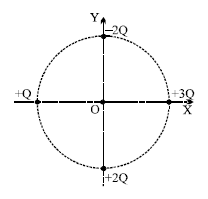
No solution provided for this question.
The charge per unit length of the four quadrant of the ring is 2λ , – 2λ , λ and -λ respectively. Th e electric field at the centre is
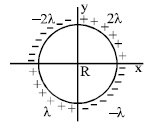
No solution provided for this question.
A thin semi-circular ring of radius r has a positive charge q distributed uniformly over it. The net field \overrightarrow{E} at the centre O is :
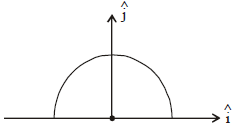
No solution provided for this question.
In the figure , ΔABC is in an isosceles triangle with A = 90°. D is the mid point of BC. Three charges 2Q, –Q and Q are placed at A, B, C respectively.
The net electric field at D due to three charges is directed along the numbered arrow :
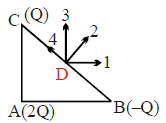
No solution provided for this question.
Find the electric field due to a circular arc of radius R and charge / length l at the origin. The arc is in xy plane and extends from θ = π/3 to θ = p w .r.t.
x-axis .
No solution provided for this question.
A block of mass m containing a net negative charge –q is placed on a frictionless horizontal table and is connected to a wall through an
unstretched spring of spring constant k. If the horizontal electric field E parallel to the spring is switched on, then the maximum compression
of the spring is :-
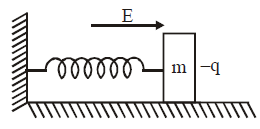
No solution provided for this question.
A point charge of 100 μC is placed at 3\hat{i}+4\hat{j} m. Find the electric field intensity due to this charge at a point located at 9\hat{i}+12\hat{j} m :-
No solution provided for this question.
Five point charges, each of value +q, are placed on five vertices of a regular hexagon of side L. The magnitude of the force on a point charge of value –q coulomb placed at the center of the hexagon is
No solution provided for this question.
A thin glass rod is bent into a semicircle of radius r. A charge +Q is uniformly
distributed along the upper half, and a charge –Q is uniformly distributed along the lower half, as shown in Fig. The electric field E at P, the center of the semicircle, is :
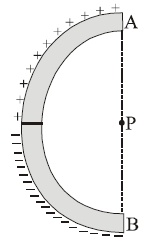
Using the direct formula for the electric field due to a uniformly charged arc:
\[
E = \frac{2k\lambda \sin(\theta/2)}{r}
\]
Step 1: Identify Parameters
- \(\lambda\): Linear charge density.
- \(k = \frac{1}{4 \pi \varepsilon_0}\): Coulomb's constant.
- \(r\): Radius of the semicircle.
- \(\theta = \pi\): Angle subtended by the semicircle at the center.
Step 2: Substitute \(\lambda\)
The total charge on the semicircle is \(+Q\) or \(-Q\), and the arc length is \(\pi r\). Therefore:
\[
\lambda = \frac{Q}{\pi r}
\]
Step 3: Substitute into the Formula
\[
E = \frac{2k \lambda \sin(\pi/2)}{r}
\]
Here, \(\sin(\pi/2) = 1\). Substituting \(\lambda = \frac{Q}{\pi r}\):
\[
E = \frac{2k \left(\frac{Q}{\pi r}\right)}{r}
\]
Step 4: Simplify
\[
E = \frac{2k Q}{\pi r^2}
\]
Since \(k = \frac{1}{4 \pi \varepsilon_0}\), substitute \(k\):
\[
E = \frac{2}{4 \pi \varepsilon_0} \cdot \frac{Q}{\pi r^2}
\]
\[
E = \frac{Q}{\pi^2 \varepsilon_0 r^2}
\]
Final Answer:
The electric field at the center is:
\[
{\frac{Q}{\pi^2 \varepsilon_0 r^2}}
\]